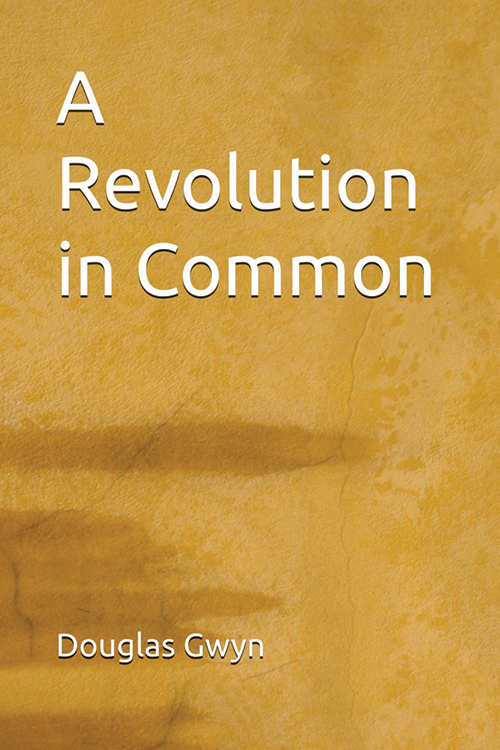
A Revolution in Common
Reviewed by Ron Hogan
November 1, 2025
By Douglas Gwyn. Plain Press, 2025. 124 pages. $10/paperback.
Douglas Gwyn is writing as fast as he can: the introduction to A Revolution in Common cites events from the early months of Donald Trump’s second presidential term, and in the final pages he identifies the dynamic relationship between Trump and Vladimir Putin (and, perhaps, Benjamin Netanyahu) as “an existential threat comparable to the Axis powers that unleashed World War II.” Trump is not the ultimate boogeyman, however. “In the shadows behind him,” Gwyn warns, “the interests of capital . . . whisper and guide.”
Gwyn brings a dramatically apocalyptic perspective to the contemporary moment. In one of the five essays that make up this thematic collection, he compares “global capitalism and the nation-states and military alliances that enforce its regime” to the tribulations of the Book of Revelation. Another begins with the gospel account of Jesus, having just arrived at Jerusalem on Palm Sunday, weeping over a city whose future doom he recognizes as inescapable. When he looks out at the modern world, Gwyn says, “I feel solidarity with Luke’s Jesus.”
Grandiose? Some might think so. Others would believe that Gwyn raises exactly the right amount of alarm, given the circumstances. The emphasis on biblical imagery becomes even more significant when we see that, rather than give in to despair, Gwyn looks back at the origins of the Quaker movement for a potential path out of the crisis. In particular, he turns to James Nayler’s concept of the Lamb’s War as the basis for “an anarchist, nonviolent cultural revolution” and “a vision—and a practice—of a more egalitarian, peaceful and environmentally sustainable future.”
Gwyn carefully distinguishes between “anarchy,” the state of chaos and disorder, and “anarchism,” the tendency to maximize personal liberty by minimizing the concentration of political power in state apparatus. He shows how Nayler, along with George Fox and other early Quakers, rebelled against the ruling powers in seventeenth-century England who, controlling both the state and the church, “alienated men and women from Christ’s light in their own consciences and deformed the social conscience generally.” He also shows how their anarchist sensibility survived into the twentieth century, citing Quaker projects such as the Movement for a New Society and the Alternatives to Violence Project.
At the same time, however, he worries that most modern-day Friends have not only failed to understand the anarchist implications of the earliest Quakers’ beliefs but remain “stubbornly uninterested” in doing so, lulled into complacency by what that first generation used to call “the gods of this world.” We (and by “we” I mean, more precisely, “many of us”) haven’t completely blinded ourselves to the suffering and inequality of this world, of course; we often work to bring healing and justice where we can. But we do so while maintaining a belief in the fundamental propriety of global capitalism’s organizing principles.
As an alternative, Gwyn offers a vision of the commons, and he isn’t just talking about the land and resources left over after the wealthy have staked their claims. He sees all of existence as “a common of both space and time, of histories and cultures,” a shared environment which can, ideally, offer each of us what we need to pursue the sort of peaceful, prosperous life that fosters communion with what, in an ecumenical spirit, Gwyn refers to as “the One.”
He suggests organizing ourselves on a model of federation, a system of covenantal relationships between people (or societies) who regard themselves as equals and give each other room to pursue their individual goals, as long as they don’t conflict. Nation-states would still exist in this world but with sharply diminished powers. In particular, given that nation-states have done less than stellar work in sustaining economies and ecologies that support all people justly, much of that work would be reassigned to a growing network of nonprofit organizations.
As an anarchist at heart (and a democratic socialist as a matter of practicality), I resonate with much of A Revolution in Common. I don’t agree with all of the details of Gwyn’s vision, like his confidence that obligatory national service “would draw us out of our cultural silos, shape young consciences, and nurture our collective conscience.” I worry that our nation-states may have already declined too far, that bad actors could too easily manipulate such programs to the Empire’s ends. But I believe that he has hit upon something true about the state of the world, and I agree with him that “the apocalyptic, anarchist consciousness of the first generation [of Friends]” can guide us out of our overlapping crises and toward a happier future.
Ron Hogan is the audience development specialist for Friends Publishing Corporation. He shares weekly Scripture-centered messages on Quaker.org and through our email newsletter. He is also the author of Our Endless and Proper Work.



Comments on Friendsjournal.org may be used in the Forum of the print magazine and may be edited for length and clarity.